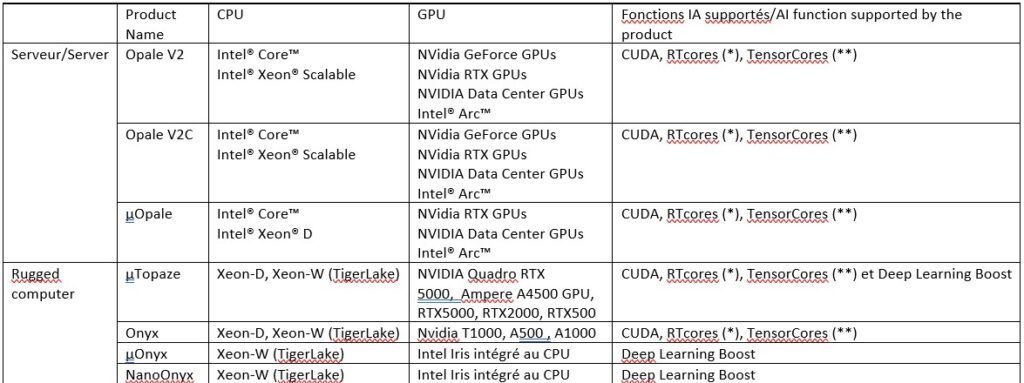Introduction
Artificial intelligence (AI) is one of the most revolutionary technologies of recent years. It has already transformed many sectors, and the embedded industry is not an exception.
GPUs (Graphic Processing Unit) have played a crucial role in the development of AI and especially in the acceleration of deep learning solutions. Today, in addition to supporting the development of the gaming market, some GPUs provide advanced computing functions that are essential to many embedded Mil-Aero or industrial applications: control command, decision support devices, electronic warfare, surveillance (Radar Sonar), cyber security etc.
But these applications have their own constraints, to summarize them we often use in our jargon the Swap-C acronym (Size, Weight, And Power - Cost), and the graphic solutions proposed by Intel, AMD, and NVIDIA is logically and obviously intended to a broader market (PC, Video Games, CAD) whose technical challenges are different in many ways.

What are the different types of GPUs offered by the market?
In the late 1990s, GPUs were developed to improve the graphics capabilities of computers and to relieve processors of display functions previously assigned to them. Over time, they have become more flexible and programmable, offering significant improved calculation capacities, surpassing those of processors for certain applications. Alongside the development of GPUs to process increasingly realistic visual effects, they have transformed into real high-performance data processing units to become GPGPUs (General-Purpose Computing on Graphics Processing Units).

Integrated GPUs
Processors but also FPGAs (Field Programmable Gate Arays) equipped with a fully integrated GPU (iGPU) make possible to develop more lighter systems, needing less power and therefore being cheaper, and more efficient thanks to a strong coupling between digital cores.
Nowadays, using iGPUs in embedded systems remains relevant for integrators looking to optimize their ECUs (Electronic Control Units) or computers by primarily leveraging video or chip display interfaces with moderate graphics resources.
However, although the offer of processor manufacturers is constantly being enriched, the use of dedicated or discrete GPUs is often necessary for applications that require 3D processing or parallel computing such as deep learning.
Discrete GPUs
Discrete GPUs or dGPUs are graphics processors separate from the CPU having their own processing units (cores) and integrated video memories (RAM). dGPUs are typically used in demanding applications requiring powerful graphics capabilities and are particularly efficient and capable of performing large amounts of operations in parallel. In that way, they are recommended to support deep learning and artificial intelligence functions when combined with FPGAs or processors. However, they have the disadvantage of being very energy-intensive and requiring sophisticated cooling devices.
In this category of GPUs, we will find Intel® Arc™ discrete GPUs and NVIDIA's well-known RTX™ platform.
But there are other types of discrete GPUs that need less power and are very useful in our rugged high-performance computing (HPC):
The SM750 and SM768 dGPUs from Slicone Motions, whose main ambition is to serve as gateways between processing units without graphics capabilities and screens, or the Mali GPUs from ARM, whose key word is energy efficiency and which we will find more frequently in the field of smartphones, are two very good examples of discrete GPUs that are difficult to categorize.
Similarly, in the recent years we have seen new hybrid FPGA and high-end processor integrating discrete GPUs solutions appear on the market:
AMD offers in its range, the MPSoC Zynq™ UltraScale+ ™ which implements in the same chip several Cortex processor cores, FPGA resources and a Mali GPU. This highly integrated chip is particularly suitable for automotive or vetronic devices.
The latest generations of CoreI processors are built on the TigerLake architecture integrating the new IrisX dGPU. With this "combo" of 2 high-performance chips in a single component and the support of the Deep Learning Boost technology, Intel is enriching its Embedded line (Industrial Temperature Range, Extended Life Cycle) with a CPU that provides a real response to the growing need for resources dedicated to AI acceleration in the embedded field.

Hence, Ecrin Systems has a very wide range of solutions based on a wide variety of form factors (PCIe, MXM, XMC, VPX or other SFM such as the Jeston) to meet the equally varied GPU requirements of customers. Since the needs can range from a simple video interface with a minimum of 3D processing capacity to significant computing power for AI processing, so we have developed our rugged high-performance PCs, servers and computers to meet the expectations of the greatest number of people:

(*)RTX boards feature "RT cores" to speed up the mathematical operations needed to simulate rays (ray tracing: the generation of computer images by following the direction of light from a camera).
(**)Tensor Cores are a new advanced technology from NVIDIA that enables mixed-precision calculations. This innovation delivers significant performance gains for all AI and HPC workloads.

